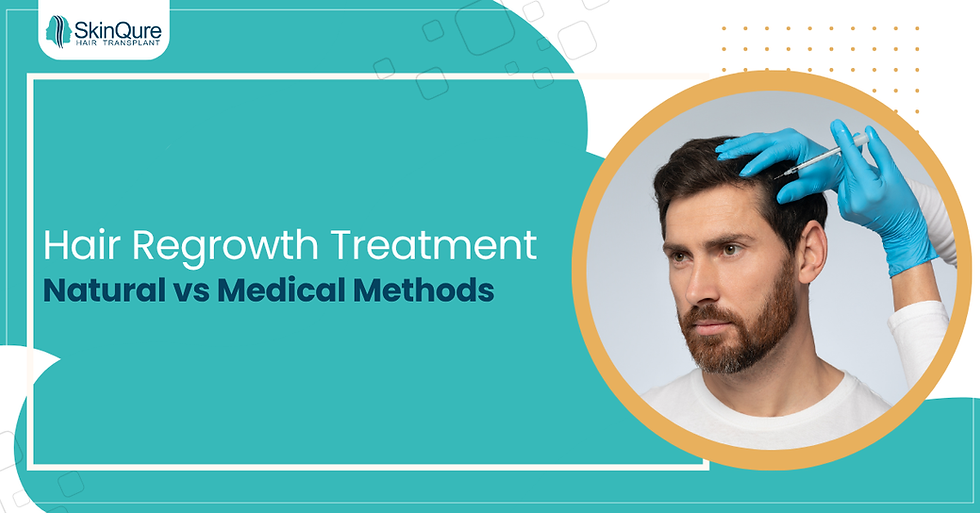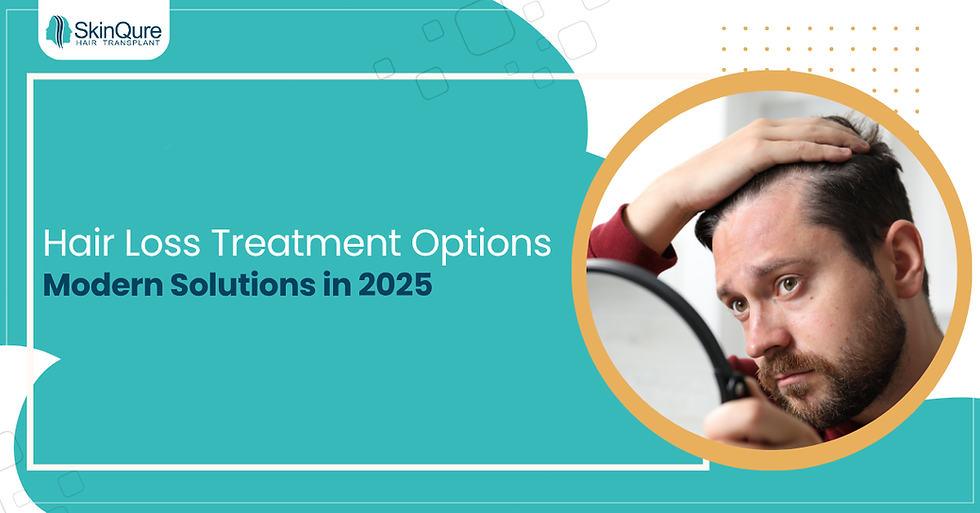Receding Hairline Solutions: Expert Treatment Options
- Dr Jangid, MD
- Oct 27
- 4 min read

A receding hairline is one of the most prevalent hair issues men and women of today experience. It usually begins with a progressive thinning of hair on the forehead and temples and then later on an M-shaped design. The majority believe that a receding hairline is natural during aging, but this is not always true. Modern treatments and proper diagnosis of today can properly manage, treat, and even reverse hairline loss. At SkinQure, with Dr. Jangid’ s expert advice, a well-known dermatologist and hair transplant surgeon, each patient is given personalized solution options to help regain confidence as well as healthy hair growth.
About receding hairline
Receding hairline happens when hair follicles reduce in size and begin to not produce healthy hair. The condition may begin as early as the twenties and gradually move on over years. Today, receding hairline is found common among men due to androgenic alopecia. Most women also suffer with this due to hormonal imbalance, stress, or malnutrition.
According to dermatology statistics, over 60% of men suffer from hairline recession by the age of 35, and about 40% of women suffer from hair thinning at the age of 50%.
Genetics, scalp ill health, pollution, and malnourishment are the key factors. An early diagnosis of the underlying cause is what will help one select the appropriate expert treatment. Dr. Jangid’ s team at SkinQure pays close attention to scalp analysis, blood testing, and trichoscopy to determine why the hairline is receding.
How does SkinQure consult patients?
Dr. Jangid, expert dermatologist, and ex AIIMs specialist Delhi, examines the scalp carefully, evaluates the hair loss pattern, and advises patients about his medical and lifestyle history.
He usually describes that prompt treatment provides more favorable results. For example, mild hairline recession can be managed with non-surgical solutions options, whereas advanced conditions can be treated with surgery for restoration. Following the assessment, he recommends treatments such as PRP therapy, GFC treatment, or Hair Transplant depending on the condition. His aim is to not only restore the hairline but also to provide long-term scalp health.
Best non-surgical receding hairline solutions
Non-surgical procedures are the first choice for most patients because they are painless and don't need any recovery time. Dr. Jangid recommends PRP (Platelet-Rich Plasma) and GFC (Growth Factor Concentrate) therapy as a treatment for initial cases of receding hairline.
In PRP therapy, your blood is used to obtain platelets that stimulate hair follicles, enhance circulation, and cause natural growth. Research has confirmed that PRP therapy can enhance the density of your hair by a significant 30% three months after undergoing regular sessions. GFC therapy also employs focused growth factors to achieve quicker and longer-lasting outcomes.
Dr. Jangid describes that regular sessions and home care, such as good scalp hygiene, a balanced diet, and recommended supplements, improve the result. These non-surgical professional treatment modalities slow down further recession and aid in natural hair growth.
Surgical hairline restoration
For serious receding hairline cases, with extensive loss of hair in the frontal region, surgical restoration is the most trustworthy expert solution. At SkinQure, FUE Hair Transplant (Follicular Unit Extraction) is the most popular procedure.
In this process, donor hair follicles are taken from the donor site, usually the back of the head and transplanted to the bald regions. The process is least painful, does not create any noticeable scars, and produces natural results. Based on clinical statistics, the graft survival rate at SkinQure is more than 90%, giving a high success ratio.
Dr. Jangid himself conducts each transplant with accuracy, providing proper hairline design, density, and direction. New growth is usually observed after 3–4 months, and complete results can be seen after 9-12 months. This solution choice not only restores one's looks but also increases self-image and confidence.
Medical treatments for hairline control
In addition to clinical treatments, Dr. Jangid also recommends medical specialist treatment in the form of Minoxidil, Finasteride, or Nutraceutical supplements. Minoxidil enhances hair follicle blood flow, whereas Finasteride prevents the hormone DHT, which leads to follicle miniaturization. These drugs, taken under guidance, can halt the receding hairline and stop the hair loss.
Tips for stopping hairline recession
According to Dr. Jangid, prevention is equal to treatment. He recommends that patients follow a holistic approach nutrition, stress reduction, and cleanliness of the scalp. Oiling at regular intervals with medicated oils, gentle hair care products, and avoiding excess heating can save follicles.
He also instructs patients regarding recognizing early warning signs such as thinning of temples or delayed regrowth upon hair loss. Early diagnosis ensures that professional treatment is more effective and provides noticeable improvements.
Why choose SkinQure for hairline treatments?
SkinQure excels with its science-driven approach, modern facility, and compassionate patient attention. Dr. Jangid deals with every case of receding hairline personally. Safety and precision are guaranteed. Global standards of hygiene are followed in the clinic and FDA-approved machines and solutions are used.
Patients appreciate the clinic’s transparent guidance and aftercare support. With years of expertise and a success rate above 95% in hair restoration, SkinQure is one of Delhi’s most trusted names for expert treatment and solutions options in dermatology.
Conclusion
Receding hairline may impact appearance and self-confidence, but contemporary dermatology holds promise. Through non-surgical treatments such as PRP and GFC or surgical solutions methods like hair transplant, outcomes nowadays are natural and long-lasting.
Dr. Jangid at SkinQure, makes sure that his patients get precise diagnosis, scientific treatment, and long-term outcomes.
FAQs
1. Which one is one of the best receding hairline treatments?
The best receding hairline treatments are PRP therapy, GFC therapy, FUE hair transplant, and laser stimulation. SkinQure offers customized expert treatment according to your condition and stage of hair loss.
2. Can a receding hairline treatment grow naturally?
Yes. Proper expert treatment with the right scalp care, healthy diet, and proper care of the scalp do aid in some regrowth of hair. More advanced solutions such as solutions for more serious cases like transplants are still needed, though.
3. How does Dr. Jangid treat a receding hairline?
Dr. Jangid provides complete consultation, diagnoses causes, and suggests personalized expert treatment. Treatment includes PRP, GFC, pills, or hair transplant as per the patient's requirement.
4. When can one see the result after treatment?
Patients see results manifest within 2-3 months. Surgical hair restoration takes 9–12 months for full regrowth.








Comments